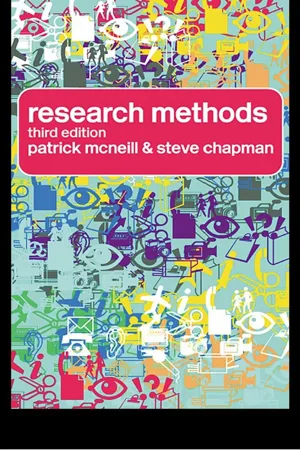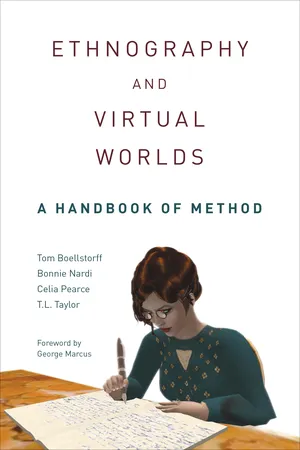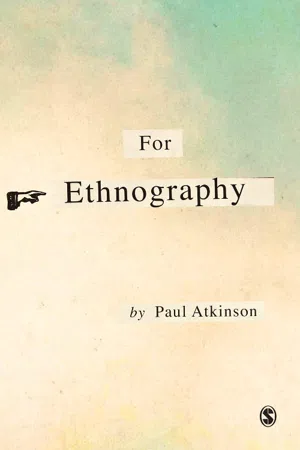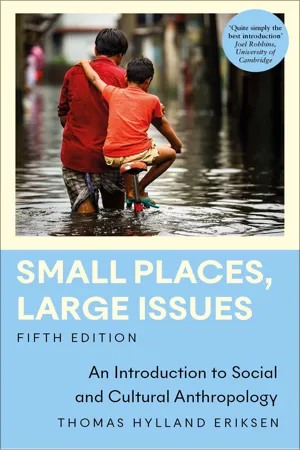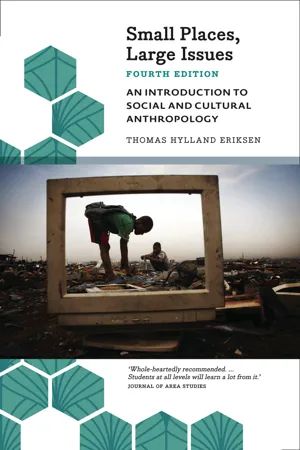Social Sciences
Ethnography
Ethnography is a research method used to study and understand social groups and cultures. It involves immersive fieldwork, participant observation, and interviews to gain an in-depth understanding of the group's customs, behaviors, and beliefs. Ethnographers aim to provide rich, descriptive accounts of the culture they study, often resulting in detailed ethnographic texts or films.
Written by Perlego with AI-assistance
Related key terms
Related key terms
1 of 4
Related key terms
1 of 3
11 Key excerpts on "Ethnography"
- eBook - ePub
- Steve Chapman, Patrick McNeill, Patrick Mcneill(Authors)
- 2005(Publication Date)
- Routledge(Publisher)
4 Ethnography‘Ethnography’ literally means writing about the way of life, or culture, of social groups. At its simplest, it involves the researcher inserting themselves into the natural setting of the social group being studied and participating in and observing their daily activities. Other methods, particularly informal interviews and the analysis of documents such as diaries may be used to sketch out a fuller picture.The purpose of such research is to describe the culture and life style of the group of people being studied in a way that is as faithful as possible to the way they see it themselves and to the social contexts in which their behaviour occurs. The idea is not so much to seek causes and explanations, as is often the case with survey-style research, but rather to ‘tell it like it is’, to capture what Brewer (2000) notes are ‘social meanings and ordinary activities’ (p. ).The aims of ethnographic research are strongly linked to the broader theoretical frameworks of phenomenology and interpretivism (see pp. ) which argue that all social action is intentional. In other words, people choose to behave the way they do. Interpretivist sociologists argue that in order to understand social life, we must first examine social interaction and especially the social meanings or interpretations that people attach to their behaviour. They argue that we can only do this by adopting ethnographic research methods because these allow researchers access to the ‘lived experience’ of particular social groups and to think themselves into the perspectives of their members.Ethnography, therefore, is about imitating real life. Weber called this ‘Verstehen’, i.e. being able to emphathize with or think like the people that are being studied. This closeness to the research subjects has led interpretivists to claim that Ethnography produces the most valid and authentic type of qualitative data of any type of social research method. - eBook - ePub
- Jonathan Lazar, Jinjuan Heidi Feng, Harry Hochheiser(Authors)
- 2017(Publication Date)
- Morgan Kaufmann(Publisher)
Chapter 9Ethnography
Abstract
In-depth, longitudinal observation of complex contexts is often necessary for understanding systems requirements or the impact of systems in use. Ethnography refers to the use of in-depth observation, and often participation, of a human group, culture, or context, with the goal of developing a rich description of activities, interactions, beliefs, roles, and goals. Ethnographic research in human-computer interaction (HCI) is particularly useful for understanding environment where stakeholders interact to complete complex tasks involving the need for coordination and exchange of information. This chapter discusses the selection of sites, identification of research roles, practical issues for ethnographic studies, and processes involved in collecting and analyzing ethnographic data. Examples of ethnographic HCI studies in home, work, education, and other settings are provided.Keywords
Ethnography; Observation; Participation; Informants; Triangulation9.1 Introduction
You've just been offered a fantastic opportunity to become involved in the design of an innovative new health-care information management system, to be used in hospital intensive-care units in a country that you've always wanted to visit. Your job is to design an integrated set of user interfaces, based on a detailed understanding of system requirements, organizational concerns, work practices, and a multitude of other relevant factors. - eBook - ePub
- Christopher Crouch, Jane Pearce(Authors)
- 2013(Publication Date)
- Berg Publishers(Publisher)
6In the Picture: Ethnography and ObservationWhat is Ethnography?
Ethnographic research has a long tradition, and provides a useful introduction to the social research processes we discuss in this book. Its name reflects the key goal of Ethnography, which involves the description of, or writing about, a particular cultural group or particular cultural practices. An ethnographer can therefore be characterized as both researcher and writer. In this chapter we explore the potential of ethnographic approaches to research in design, with a particular focus on the value of ethnographic research to identify and elaborate the social and cultural dimensions of design problems and solutions. We begin by describing classic ethnographic research, tracing the methodology back to its roots in anthropology. We then consider some key methodological and epistemological concerns associated with Ethnography and explore how ethnographic approaches and aims have evolved in response to post-colonial and globalized contexts. The chapter then focuses on methods for conducting observations as part of an ethnographic study, concentrating on the possibilities, cautions and strategies associated with observation. Finally we outline some examples of research in design where ethnographic approaches might be applied.The origins of Ethnography
Ethnographic research grew out of the discipline of anthropology: the study of human beings, their lived experiences and their cultural practices. As a discipline, anthropology became important when colonial expansion led to the ‘discovery’ of societies of people living in geographically remote parts of the world, far away from the centres of colonial power. Anthropological researchers were intrigued by the differences between the practices of the newly discovered societies and those of the groups at the colonial ‘centre’, and attempted to document and explain how those newly discovered societies experienced daily life. Anthropological research was typically empirical, and took place in the field; anthropologists would spend long periods of time (several months or even years) living alongside the people under scrutiny, immersed in their daily lives, and recording the experience in the form of field notes or diaries. - eBook - ePub
Introducing Qualitative Research
A Student′s Guide
- Rosaline Barbour(Author)
- 2013(Publication Date)
- SAGE Publications Ltd(Publisher)
The discussion then turns to the Practice of Ethnography, and perennial issues, such as the positioning of the researcher and her/his ‘insider’ or ‘outsider’ status, the ethnographer's role, and fieldwork relations are discussed. Guidance is provided with regard to planning fieldwork and observation, generating and recording fieldnotes and anticipating analysis. Discussion will also draw on fieldwork data generated by the author in relation to past projects (on socialization for social work and the negotiation of responsibility in the work of midwives). Data excerpts are used to illustrate the specific challenges and dilemmas raised by this approach to generating qualitative data and strategies for dealing with these are discussed. (Further fieldnote excerpts are provided on the companion website www.sagepub.co.uk/barbour2e) Finally, the issues relating to Ethnography and Representation will be explored. The Focus of Ethnography According to Angrosino, the field-based discipline of Ethnography ‘is the art and science of describing a human group – its institutions, interpersonal behaviours, material productions and beliefs’ (2007: 14). The principal task of Ethnography is to convey a detailed account of ‘life’ in a specific cultural setting – whether this is the ‘exotic’ and far-away (as in traditional anthropological studies) or closer to home (in terms of researching specific events, groups or subcultures, or institutions. It relies, perhaps even more markedly than other forms of qualitative research, on the presence of the researcher – as Punch (1994) emphasizes, the ethnographer is the research instrument. The other defining feature is the in-depth immersion in the field that is involved – whether this is in terms of the significant length of time spent in the field (at least a year and often longer following anthropological convention); or (as in some more recent variants) in terms of the range of interactive events and materials that are drawn on as data - eBook - ePub
Ethnography and Virtual Worlds
A Handbook of Method
- Tom Boellstorff, Bonnie Nardi, Celia Pearce, T. L. Taylor(Authors)
- 2012(Publication Date)
- Princeton University Press(Publisher)
This myth that Ethnography is less valid than quantitative research is, of course, shaped by beliefs about validity itself. Validity denotes the extent to which a scientific explanation corresponds to the actual world. In the 1970s Ulric Neisser issued a sharply worded critique of the scientific validity of experiments. His provocative commentary, while directed at fellow psychologists, also articulated long-standing disquiet among ethnographers and others about the validity of data obtained from experiments: “The subject is isolated, cut off from ordinary environmental support, able to do nothing but initiate and terminate trials that run their magical course whatever he may do. . . . Experimental arrangements that eliminate the continuities of the ordinary environment may provide insights into certain processing mechanisms, but the relevance of these insights to normal . . . activity is far from clear” (1976:36). Neisser’s problematic was termed “ecological validity.” While ethnographers did not name the problem, Ethnography came into being precisely to create a research paradigm in which human beings could be studied with no fear of compromising ecological validity. Ethnographic practice is, in essence, the opposite of psychological experimentation. Ethnographers observe people in interaction with other humans and their social and physical contexts, which together compose the “environmental supports” of which Neisser spoke. As people, we arrange our lives and societies such that the environment presents a constant, flexible repertoire of resources. Ethnographers address systems of support anchored in culture. We organize ethnographic investigation so that we can access the complex arrangements by which people solve problems and make meanings. Our work has a high degree of validity because we directly observe and interact with what we want to know; we do not wrench phenomena out of their contexts, thereby rendering them uninterpretable.Ethnographers have been devoted to avoiding the problem of separating the human from his or her context. The ethnographic approach of landing smack in the middle of an ongoing culture or activity in order to study it means that we must rely on qualitative methods of observation and conversation to absorb and analyze what is taking place around us. The very immediacy of the experience of life, its patterns and rhythms, its artifacts and practices, is not easily expressed in numbers. An ethnographer thrust into a culture is invariably awed and humbled by its vitality and charisma; we express our understandings and insights in nuanced reports and narratives that attempt to recover as much as possible of the animation and interest stimulated by culture as an object of inquiry.Validity is essential to science’s most fundamental purpose—to faithfully represent the world. We are not arguing that human life defies quantitative study or experimental methods. Such a proposition is clearly untrue. We are arguing that qualitative research can yield profound insights that elude quantification. Arguments that presuppose that only quantitative data are the stuff of science lack cognizance of the complex material and immaterial elements that constitute human life, which is best understood through both qualitative and quantitative approaches.Ethnography is a flexible methodology, and ethnographers devise and use whatever tools are needed for the job. Although ethnographers emphasize qualitative methods, we may use quantitative approaches as well. Indeed, a cliché of anthropology is an ethnographer beginning his research in a remote village by conducting a census. Malinowski recorded that when he reached the Trobriand Islands, “I took a village census, wrote down genealogies, drew up plans, and collected the terms of kinship” (Malinowski 1922:4). As a contemporary example of the use of quantitative methods, Bonnie had long noticed that World of Warcraft players often played with family and friends. To determine more precisely the extent of such practices, she analyzed survey data from North America, Europe, Hong Kong, and Taiwan in which about 75 percent of players stated that they played with at least one person they knew (Schiano et al. 2011). This finding contributed to the ongoing body of qualitative research dispelling notions of gamers as loners and social misfits (Taylor 2006a; Pearce and Artemesia 2009). The quantitative finding is a crisp number, easy to communicate to others, and a reasonably precise measure of the extent to which players play with those they already know in the physical world. - eBook - ePub
- Paul Atkinson(Author)
- 2014(Publication Date)
- SAGE Publications Ltd(Publisher)
I am motivated by something a bit more thoroughgoing than the need simply to give readers some useful analytic pointers, based on a reaction to contemporary fashions in social research. I am not alone in thinking that there are some profound and widespread problems in contemporary methodological thought and research practice. That can be summed up as a loss of social-scientific imagination, and a divorce of ethnographic research from its disciplinary roots. As a consequence, key features of ethnographic research are being lost to view and need to be re-stated and re-emphasised. There is absolutely no doubt that varieties of ‘qualitative’ research have become prominent in recent decades. The sheer volume of published research and of methodological texts is remarkable. Although it has become commonplace to complain about the embattlement of qualitative research and the apparent preference for numerical analysis on the part of influentials (such as funding bodies or appointing committees), qualitative research projects – ethnographies among them – are in the ascendant in some of our disciplines, and they have well-established footholds in others. Obviously, social and cultural anthropology remains almost synonymous with ethnographic practice, and ‘the Ethnography’ (such as the resulting published monograph) is the mainstay of the discipline. Indeed, many anthropologists speak and write as if they and they alone undertook such fieldwork. Elsewhere, the emphasis has often been on ‘qualitative’ research, or ‘qualitative inquiry’ as it is also becoming known (with connotations that rather take us beyond the scope of this present book). Such research strategies have become widespread in sociology, cultural studies, human geography, education, nursing and healthcare studies, social psychology and indeed the entire spectrum of human, social disciplines.Unfortunately, in the process, the original inspiration and thrust of ethnographic field research has become diluted. We have lost a number of things. First, we seem to have lost the understanding that the conduct of Ethnography involves an intensive period of engagement (‘participant observation’) in a given social milieu. Too often we discover the studies that have been called ‘ethnographic’ are nothing of the kind, but are based entirely on interviews, and contain absolutely no engagement with a ‘field’ of social activity. This is not just a matter of personal commitment or faith. My implied criticism here is not simply that interviews alone represent the easy way out, and are essentially a lazy way of undertaking social research. (As a matter of fact, I do feel that, and I also believe that the increasing use of strategies like focus groups is an even more lazy and superficial way of conducting research.) Rather, the fundamental problem is this: ethnographic fieldwork – in a variety of forms – is essential if we are to grasp a number of basic issues in everyday social life and its routine conduct. These are not matters of choice or style, therefore. I remain committed to the view, as I have been for over forty years, that the conduct of ethnographic work is predicated on a number of key issues. I shall outline them in the following paragraphs. - eBook - ePub
- Martyn Hammersley(Author)
- 2013(Publication Date)
- Routledge(Publisher)
discovered ; that this can only be achieved by first-hand observation and participation in 'natural' settings, guided by an exploratory orientation; that research reports must capture the social processes observed and the social meanings that generate them. On the basis of these assumptions, Ethnography is directed towards producing what are referred to as 'theoretical', 'analytical' or 'thick' descriptions (whether of societies, small communities, organisations, spatial locations or 'social worlds'). These descriptions must remain close to the concrete reality of particular events, but at the same time reveal general features of human social life.The claim to integrate description with theory is one of the most distinctive characteristics of Ethnography. In this chapter I shall argue that this concept of theoretical description is problematic. It can be interpreted in several ways, all of which raise difficult questions. Furthermore, I believe that ethnographers' adoption of the goal of theoretical description has led to a fundamental misconception about the nature of the descriptions and explanations they produce. I will examine each aspect of this dual goal of Ethnography in turn.Ethnography as Theory
While Ethnography places great emphasis on description, it claims to offer a distinctive kind of description: theoretical description. But the nature of this distinctiveness is not very clear. On the one hand, descriptions cannot be theories. Descriptions are about particulars (objects and events in specific time-place locations), whereas theories are about universals (relations between categories of phenomena that apply wherever those phenomena occur). On the other hand, all descriptions use concepts which refer to an infinite number of phenomena (past, present, future and possible). And all - eBook - ePub
Small Places, Large Issues
An Introduction to Social and Cultural Anthropology
- Thomas Hylland Eriksen(Author)
- 2023(Publication Date)
- Pluto Press(Publisher)
There is no standard recipe for how to carry out fieldwork. The kinds of relationship established with local interlocutors depends on the context and research questions, and the gender, race and age of the ethnographer also matters. However, there are some shared criteria, regardless of the nature of the field, to which we now turn briefly.IN THE FIELD
Some social scientists may be compared to passengers in a hot-air balloon sailing slowly across a landscape. The view is impeccable, and the passengers can draw the big picture of hills, towns, meandering rivers, meadows and pastures at their leisure. They have brought binoculars and can measure, count and offer a fabulous overview of the region after mooring. Other social scientists are more similar to hikers. They walk along footpaths while noticing the flowers at the roadside, dung beetles and trees, humans on their way to town or sitting on a tractor. They sometimes bend down, whip out their magnifying glass and make a detailed study of the movements of the ants on the ground.It is not difficult to guess which of the two is the anthropologist. Every method has its pros and cons, and the gold of Ethnography consists in small nuggets which are made to shine by hand polishing, not machinery.One principal requirement in fieldwork consists in trying to take part in local life as much as possible. Anthropologists also use a variety of specified, formal and informal techniques for the collection of data (see Atkinson et al. 2007; Barnard and Gravlee 2015). Depending on the kind of fieldwork one is engaged in, structured interviews, statistical sampling and other techniques may be required to varying degrees. Most anthropologists depend on a combination of formal techniques and unstructured participant observation.Participant observation refers to the informal field methods which form the basis for most fieldwork, whether or not it is supplemented with other techniques. The aim of this method is to enter as deeply as possibly into the social and cultural field in which research takes place; in practice one becomes, as Evans-Pritchard remarks (1983 [1937], p. 243), a ‘doubly marginal’ person, in a sense suspended between one’s own society and the society under investigation. During participant observation, one tries to immerse oneself into the life of the locals and tries not to be noticed, so that locals can carry on with their own lives as usual. In this regard, the issue of hidden versus open observation has been discussed in the anthropological community. The ethical guidelines of the professional associations nonetheless state in no uncertain terms that it is unethical not to inform your hosts what you are up to. The people explored must have the right to refuse to be subjected to anthropological analyses; in the case of hidden observation, they are deprived of this possibility. - eBook - ePub
Small Places, Large Issues
An Introduction to Social and Cultural Anthropology
- Thomas Hylland Eriksen(Author)
- 2015(Publication Date)
- Pluto Press(Publisher)
3Fieldwork and EthnographyTheory without data is empty, but data without theory are blind.— C. Wright MillsFieldworkAnthropology distinguishes itself from the other social sciences through the strong emphasis placed on ethnographic fieldwork as the most important source of new knowledge about society and culture. A field study may last for a few months, a year, or even two years or more, and it aims to develop as intimate an understanding as possible of the phenomena investigated. Many anthropologists return to the same field throughout their career, to deepen their understanding further or to record change. Although there are differences in field methods between different anthropological schools, it is generally agreed that the anthropologist ought to stay in the field long enough for their presence to be considered more or less ‘natural’ by the permanent residents, the informants, although they will always to some extent remain strangers.Many anthropologists involuntarily take on the role of the clown in the field. They may speak strangely with a flawed grammar; they ask surprising and sometimes tactless questions, and tend to break many rules regarding how things ought to be done. Such a role can be an excellent starting-point for fieldwork, even if it is rarely chosen: through discovering how the locals react to your own behaviour, you obtain an early hint about their way of thinking. We are all perceived more or less as accidental clowns or just socially inept in unfamiliar surroundings; there are so many rules of conduct in any society that you will necessarily break some of them when you try to take part in social life in an alien society. In Britain, for example, it is considered uncultured to wear white socks with a dark suit; still, it is perfectly conceivable that people who are not fully conversant with the local dress code do so. (In the field, anthropologists have been known to commit rather more serious mistakes than this.) - eBook - ePub
- Donal Carbaugh, Patrice M. Buzzanell(Authors)
- 2009(Publication Date)
- Routledge(Publisher)
RESEARCHING CULTURE IN CONTEXTS OF SOCIAL INTERACTION An Ethnographic Approach, a Network of Scholars, Illustrative MovesGerry Philipsen
In this chapter I report on an approach to the study of communication, and on the work of an interconnected group of scholars within the discipline of communication that is actively using and improving this approach in multiple contexts, languages, cultures, and arenas of practice. The approach is grounded in a simple but profound and consequential learning that, over the years, the participants in this group have achieved through their disciplined and systematic studies. That learning is that wherever and whenever there is communication, there are traces of culture laced through it. The learning began as a working assumption, adopted several decades ago (Philipsen, 1989a). Now it stands as a rich and robust finding demonstrated across the work of this group, in the past and in multiple ongoing projects. Our enterprise has been principally an academic and theoretic one. But we have also learned that these traces of culture, and the understandings we produce of them, are an important force in the lives of individuals and communities.The chapter unfolds in three related parts. First is the approach that I and my colleagues take to the study of communication: (1) a focus on local means and meanings of communication in particular social milieus; and (2) an ethnographic method for the study of those means and meanings in any given situation. Second is the development, within the communication discipline, of a network of scholars who practice this approach and educate others to use it. The third presents two examples of how participants in this network are applying this approach to the study of cultural factors in communication in order that they might understand and shape communication in important arenas of contemporary social practice. - eBook - ePub
- Anna Davies, Keith Hoggart, Loretta Lees(Authors)
- 2014(Publication Date)
- Routledge(Publisher)
It is an approach to learning about the social and cultural life of communities, institutions and other social settings. It is social scientific and investigative and can be inductive. It emphasizes and builds on the perspectives of people in a research setting (both the researched and the researcher). When undertaken well, it employs rigorous methods of data collection, which try to avoid personal bias by questioning researcher values as interpretations are formulated and assessed, and as far as possible seeks to ensure the accuracy of information used (namely, cross-checking and questioning validity claims). 13 In the past, participant observation was seen as a tool that permitted researchers to learn about new situations from the perspective of ‘insiders’. Some still see this as a key feature, given that researchers become involved in social settings and acquire knowledge through hands-on experience (LeCompte and Schensul 1999 : p. xv). More recent accounts conceptualize the approach in a more refined manner. As Madge (1993) has put it, fieldwork is an interactive text that is created from dialogues, in which researcher and researched not only learn from one another but potentially change one another as the process evolves. As such, while perhaps starting as an ‘outsider’, as fieldwork progresses there is a transcending of ‘insider’—‘outsider’ status. Unless subject to extraordinary bad luck or ineptness, the interpenetration of positions associated with being a participant who observes (not an observer who participates) should set the researcher apart from both ‘insiders’ and ‘outsiders’ — albeit the balance requires sensitive handling (Madge 1994)
Index pages curate the most relevant extracts from our library of academic textbooks. They’ve been created using an in-house natural language model (NLM), each adding context and meaning to key research topics.
Explore more topic indexes
Explore more topic indexes
1 of 6
Explore more topic indexes
1 of 4
